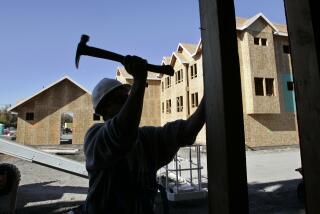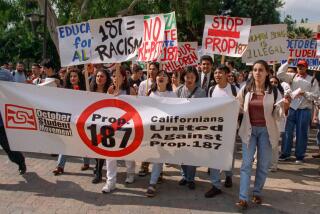PERSPECTIVE ON LATINOS : Fighting War on Backs of the Poor : The percentage of Latinos in the war is debatable; the war’s effect on domestic injustices is not.
LA number of newspapers in Latin America and Chicano activists here are playing into the hands of the war-backers by claiming that about 40% of the U.S. troops in the Gulf are Latinos. It is an exaggerated claim that makes it easy for the government to portray Latino anti-war protesters as irresponsible.
Predictably, the Department of Defense, a master of propaganda, has taken the initiative in discrediting Latino critics of the war, alleging that Latinos constitute only 4.8% of the Army’s combat-ready troops and 8.2% of its combat Marines. Significantly, only 3.2% of the more technically trained airmen in “Desert Shield” are Latino (the data for “Desert Storm” is not yet available). The false implication is that since Latinos constitute 8% of the population, they are not overrepresented in the Gulf War.
But, as a colleague once said, “Statistics lie, and liars figure.” The truth is that the measure of the Latinos participating in “Desert Storm” is skewed by using national statistics. If the gauge were the five states where Latinos are concentrated--especially California and Texas--it would show a dramatic over-representation of Latinos in the military compared to the state population. Thus far the Defense Department has not broken down its ethnic data into states and cities, and unfortunately Latinos have not pressed it to do so. Latinos are over-represented also when you consider the pool of available recruits.
Beyond the numbers, what worries me is that the ethnic composition of the Nintendo Army is an illusion that a prolonged war will bring tumbling down with even more of the poor forced into the service. Before the Gulf War, the volunteer Army was touted as a way to pay for a college education. The commercials were seductive: “Be all that you can be!” To qualify, a recruit has to have a high school diploma or a general-equivalency diploma, pass the Army’s entrance exam and be a legal resident.
While I am delighted that the 40% estimate is not correct, it is ironic that it is the lack of educational opportunities caused by institutional racism that limits the Latinos’ ability to compete with poor African Americans and Anglo Americans for what at the time seemed like safe jobs. A case in point is a recent American Council of Education report showing that nationally, only 55.9% of Latinos completed high school in 1989, versus 82.1% of Anglo Americans and 76.1% of African Americans, drastically reducing the available pool for the Army. Add to this a significant number of Latinos without green cards or who are pursuing amnesty.
But scenarios change and it is only a matter of time before ground forces will be fighting in the Persian Gulf or some other area to impose President Bush’s “new world order.” It is unlikely that middle-class white Americans will tolerate a situation where their children bear what they perceive as an unfair share of the casualties. It will be then that they will reinstitute the draft to extend the democratic privilege of dying to greater numbers of Latinos, regardless of their level of education.
We can only speculate on what the impact of a prolonged war will be on Latinos: During the Vietnam War, Latinos made up about 12% of California’s population while representing about 22% of the state’s casualties. Today, Latinos have grown to 33% of California’s elementary and high school students; Latinos constitute 63.3% of the Los Angeles Unified School District (by contrast, Latinos were 22% of the district in 1970).
The future becomes more discouraging when you realize that wars are fought by the young, and nationally white Americans are graying--their median is nearing middle-age, whereas the median for Latinos is under 25. The number of whites (male and female) between 18 and 24 dropped 10.8% from 1984 to 1989, from 23.3 million to 20.8 million, while Latinos in that bracket grew from 2 million to 2.8 million, a jump of almost 40% in five years.
In addition to human costs, this nation will pay tremendous social costs. Bush’s wars are reducing, not enhancing, educational opportunities. And the decay of the nation’s education infrastructure is making it impossible for Latinos to close the gap. In 1976, Latinos nationally represented 2% of those earning bachelor degrees; 13 years later, although the college-age population doubled, this number increased just to 3%.
It does not take a lip reader to deduce why Bush’s proposed budget reduces student loans, aid to education and Medicare.
The United States had the highest child poverty rate--two to three times that of most other industrial nations--in a recent study by the Urban Institute of eight industrial democracies. More than 42% of Latino children under the age of 18 live in poverty. Is it equitable to ask this sector of society to make further sacrifices while taxes are reduced for the rich?
In pressing their arguments against the war, Latinos should remember one of the great lessons of the Vietnam War--body bags tell only part of the story. When Vietnam was behind us, Americans remained separate and unequal. No number of American flags or yellow ribbons can erase this fact.
More to Read
Sign up for Essential California
The most important California stories and recommendations in your inbox every morning.
You may occasionally receive promotional content from the Los Angeles Times.









